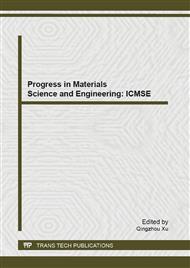p.860
p.868
p.875
p.880
p.886
p.893
p.898
p.905
p.910
Influence of Acidic Impurities on Rheological Properties of Boron/Agglomerated Boron and HTPB Slurry
Abstract:
The rheological properties of HTPB mixed with boron (B) or agglomerated boron (TB) were investigated to explore the effect of the impurities of boron on the processing of propellant. The phase structure, morphology, and acidity of each sample were characterized by XRD, SEM and pH, respectively. The results show that rheological property of B/HTPB can be significantly improved by agglomerating boron with binder. Time has little effect on the viscosity of TB/HTPB while that of B/HTPB is a strong function of time. The viscosity of TB/HTPB decreases when the temperature increases from 303K to 343K, while that of B/HTPB decreases from 303K to 323K and then increases sharply after 323K. After agglomerating with binder, the Tonset of boron reduces from 1056K to 954K and Tp drops from 1076K to 998K. Compared with B2, the weight gain and oxidation degree of TB2 increases by 27% and 8.5%, respectively.
Info:
Periodical:
Pages:
898-904
Citation:
Online since:
October 2013
Authors:
Keywords:
Price:
Сopyright:
© 2013 Trans Tech Publications Ltd. All Rights Reserved
Share:
Citation:


